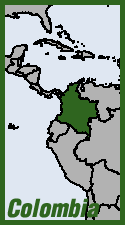 Since Colombia's FARC guerillas called off their unilateral ceasefire following a military air-strike last month, peace talks with the government have resumed in Havana. As the new phase of talks opened May 25, FARC leaders appealed to the government to instate a bilateral ceasefire. (EFE, May 25) But the very next day, government forces carried out a mixed land and air assault on a camp of the FARC's 18th Front along the Río Chimirindó, in Riosucio municipality, in the Pacific coastal region of Chocó—leaving 41 guerillas dead. Among the dead was the 18th Front's commander, Román Ruiz, authorities said. (El Teimpo, May 26) The day after that, Colombia's air force carried out a new bombardment, targeting the 4th Front of the FARC's Magdalena Medio Bloc at the hamlet of Alto la Cruz, Segovia municipality, in the inland region of Antioquia. Ten guerillas were killed in the air-strikes—which came as the climax of a three-day operation in the area that authorities said left 36 guerillas dead. (El Tiempo, May 27)
Since Colombia's FARC guerillas called off their unilateral ceasefire following a military air-strike last month, peace talks with the government have resumed in Havana. As the new phase of talks opened May 25, FARC leaders appealed to the government to instate a bilateral ceasefire. (EFE, May 25) But the very next day, government forces carried out a mixed land and air assault on a camp of the FARC's 18th Front along the Río Chimirindó, in Riosucio municipality, in the Pacific coastal region of Chocó—leaving 41 guerillas dead. Among the dead was the 18th Front's commander, Román Ruiz, authorities said. (El Teimpo, May 26) The day after that, Colombia's air force carried out a new bombardment, targeting the 4th Front of the FARC's Magdalena Medio Bloc at the hamlet of Alto la Cruz, Segovia municipality, in the inland region of Antioquia. Ten guerillas were killed in the air-strikes—which came as the climax of a three-day operation in the area that authorities said left 36 guerillas dead. (El Tiempo, May 27)
The FARC meanwhile revealed that among the 26 killed in the May 22 air-strike in Cauca region that ended the ceasefire was Jairo Martínez, a guerilla leader who had actually taken part in the Havana talks. (El Tiempo, May 27)
As a good-will gesture, President Juan Manuel Santos did announce that guerillas slain in combat would no longer be buried as "NN" (ningún nombre, or "no name"), but efforts would instead be made to identify them and have the remains turned over to their families for burial. (El Espectador, May 25) But this is a far cry from answering the FARC's call for a bilateral ceasefire.
Shedding light on the continuing roots of the conflict, the New York Times on June 2 followed up on the Colombian government's encouraging decision to halt the US-led program of glyphosate-spraying to wipe out coca crops. The report finds that even in the area known as La Macarena (in the eastern Andean foothills of Meta region), which the government had made a showcase of alternative methods to combat coca cultivation, the program has fallen short of expectations. Aid has been provided to encourage "substitution crops" like cacao, corn and plaintains. But, eight years after the Macarena program began, promised roads and electrification have still not been delivered—leaving the region in squalor and isolation. These are exactly the conditions that led local campesinos to turn to coca-growing and to support the FARC in the first place.
Cross-post to High Times







Recent comments
3 weeks 3 days ago
7 weeks 2 days ago
11 weeks 2 days ago
12 weeks 15 hours ago
22 weeks 15 hours ago
26 weeks 1 day ago
27 weeks 1 day ago
27 weeks 1 day ago
48 weeks 2 days ago
1 year 2 days ago